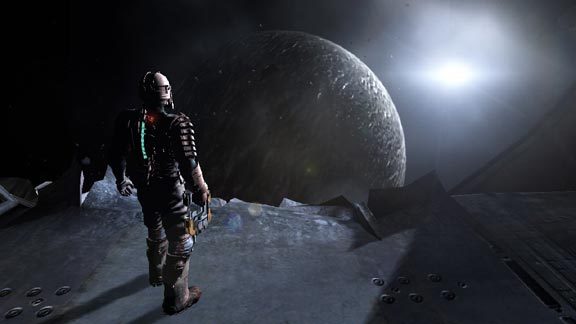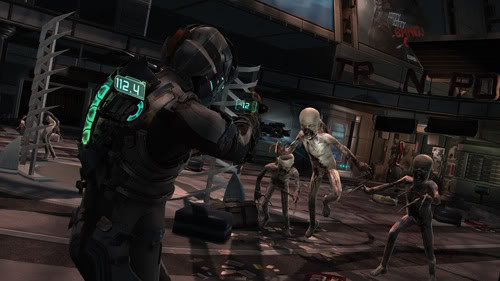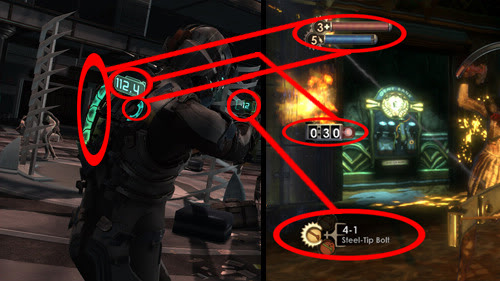This post has not been edited by the GamesBeat staff. Opinions by GamesBeat community writers do not necessarily reflect those of the staff.

Half-Life, Ico, Braid, Uncharted 2, BioShock, Portal, and Dead Space: These are important, landmark titles that share a peculiar and seemingly ineffable quality. You may have sensed it. In fact, if you're a fan of any of these titles, I'm almost certain you have. They are experiences that sublimate: games that transcend what you thought the medium you adopted in your childhood could achieve.
Visceral Games' Dead Space 2 clarifies this odd connection. It's a weird opus that recombines the tropes of the third-person shooter with the conventions and directorial acumen of classic narrative-focused filmmaking. Like the titles listed above, it's a game that elevates itself above the rest: It doesn't rely solely on its twists and turns to leave an indelible imprint on your brain. In fact, the story isn't even that interesting or novel. Instead, it's how Visceral delivers the story that is of special note.
Dead Space 2 and its pioneering contemporaries share an almost imperceptible "it" factor having to do with their narrative delivery method. But what is it that makes these "important" titles so important? The answer is simpler than you might think.
It seems to me that the commonality between them is that they all contain diegetic elements. These features have, in some great or small way, moved the effort of narrative-based gaming forward.
OK…so maybe it's not that simple. But once you get your head around the notion of "diegesis," it's not too bad. I promise.
For the sake of clarification, here's how the Yale Film Studies website defines the term:
[Diegetic elements] include objects, events, spaces and the characters that inhabit [the narrative], including things, actions, and attitudes not explicitly presented in the film but inferred by the audience. That audience constructs a diegetic world from the material presented in a narrative film.
More simply, diegetic elements are fictive components that explicate a world within the confines of a story's "narrative bubble." Film critics often employ the notion to talk about a movie's music. A simple example of diegesis would be the use of an on-location jukebox to score a scene, rather than the non-diegetic overlaying of an externally evocative orchestration.
Diegetic explanations create seamless fictional worlds. In essence, they allow a medium to get out of its own way. They reduce viewer distraction because they eliminate the need to muse over the origins of a sound or a text overlay. Fortunately for books and movies, non-diegetic elements do very little to intrude upon a viewer's suspension of disbelief. Chapter titles and film scores can even add to the tone of the piece as a whole, thereby enriching the experience. This isn't the case in video games. Health meters and item screens do very little to further the aims of the creators' narrative vision.

Dead Space 2 uses diegetic displays to convey key info: health, stasis, air, and ammo.
With this explanation of the value of diegesis in hand, I would like to present a claim: Within the popular culture, Dead Space 2 does more to advance the cause of narrative-based gaming than any other title before it.
Why Dead Space 2 fits the bill
First, I would like to offer a disclaimer: This is in no way meant to be a comparative review of Dead Space 2. I think it's an excellent game. But by my estimation, it would also place last after every title listed above, up to and including the original Dead Space, which laid the groundwork for many of things that its sequel does.
Also, before I continue, I would like to point out two considerations to keep in mind as I make my argument:
- A game that significantly advances the cause of in-game storytelling must have the potential to imprint itself on the larger popular culture (i.e. culture outside of the medium or, more simply, high sales numbers and a high profile).
- A title that meets the first criteria must deliver the majority of its information utilizing diegetic strategies.
As you can see, titles like Ico and Braid fail to meet the first consideration, while Half-Life and BioShock fail to meet the second. The original Dead Space and Portal are arguable candidates for this accolade, but I'm of the opinion that the former did not sell well enough to fulfill the first criteria. Portal, on the other hand, meets both criteria, but I am inclined to disqualify it due to its limited scope and its station as a part of a larger compilation of games. (Call it a technicality if you like. Also, Portal 2 looks like it's doing a lot of interesting things with diegesis, but unfortunately, it's not out yet.)
Dead Space 2 fits right in there. It's a title whose profile is large enough that casual gamers are likely to be aware of it. On top of that, Visceral Games has found a host of impressive solutions to the problem of communicating vital information to the player.
Why video games are an intrinsically poor narrative medium
As the fiction of the uncanny valley continues to evaporate, graphical fidelity will inevitably become less and less important. Critics have often bandied about the notion that we can bridge the “implausibility gap” in games with better, more dynamic interactive choices. I don't disagree with this assessment. Instead, I offer that lack of choice is a proximate cause of narrative disbelief or disengagement. The medium has more fundamental problems it needs to fix first.
Using a diegetic methodology, Valve explains a how momentum interacts with portals.
Speaking in terms of ultimate causes, I think the video games present a much simpler roadblock to basic storytelling: They automatically destroy your suspension of disbelief through the persistent use of non-diegetic elements. In terms of the history of narrative, I can't think of a medium that is more intrinsically non-diegetic. At every turn, developers bombard us, as participants, with unwanted white noise — bric-a-brac leftover from an arcade era where everything was about high scores and "winning."
To prove my point, here's a list of present (and past) problems and rituals that have interpolated themselves into the experience of playing a game. All of these issues demand (or demanded) diegetic or technical redress in order to move the medium forward in terms of storytelling: pressing a power button and navigating menus to start play (as opposed to merely opening a book to its first page): failing 72-pin connectors in an NES cartridge; pressing start to pause the action; choosing a difficulty; inputting a double-affirmation of the choice you've decided on; item screens; watching a load screen; pressing a button to advance through static text-based dialogue screens; pressing a button to advance past cutscenes; cutscenes themselves; quick-time events; fail states and their accompanying fail screens; segmented tutorials; staff credits; arbitrary save/password systems; etc.
Basically, all of these elements amount to this: While the game is trying to tell you a story, it's constantly reminding you that it's a game. When you read a book or watch a movie, how often does the author or director remind you that you're reading a book or watching a movie?
Diegesis is an important notion that developers should keep in mind, and I can think of no other mainstream effort that has given more time and consideration to the topic than Dead Space 2. Nearly all of the critical information the developers need the player to see exists within the fiction of the world. The result is that The Sprawl becomes a richly defined and fully realized place.
Diegesis, design, and Dead Space 2: The future of in-game storytelling

Unlike Dead Space 2, the wildly innovative title BioShock constantly
reminds you that you're playing a game.
So what are some simple solutions to the common problems that developers often solve with non-diegetic displays? I don't have all the answers. Obviously, companies like Irrational Games (creators of BioShock) have staffs of people thinking about possible alternatives for eight hours a day, five days a week. But since I'm at risk of sounding like an armchair intellectual, here are three simple suggestions that would remove all of the basic informational overlays in BioShock:
- Health meter: A black ring around the edge of the screen that encroaches on the player's vision as damage accumulates could represent loss of consciousness.
- Eve meter: The player's Plasmid arm could have several branching veins that glow. Every time he uses a Plasmid, one of the branches "empties." The number of glowing veins indicates the number of remaining uses.
- Ammo display: The sound of a discharging gun could increase in pitch as the player nears the end of his clip.
Those suggestions aside, many challenges lie ahead. How do you incorporate a pause screen in a diegetic fashion? What about save screens? Staff credits? Even Dead Space 2 hasn't broached these core conventions of design.
Also, some narrative-focused franchises have a lot more ground to cover than others. Open-world titles like Grand Theft Auto 4 have to contend with mechanics like quest-giving and minimaps. Fallout 3's itemized dialogue options aren't a very elegant solution to the problems of in-game conversation. Final Fantasy…. Well, that franchise is basically just one big menu.
It is quite possible that developers will never find workable solutions for some of these problems. And that's fine. Some genres don't need them. I can't see why Tetris would need to convey your high score within the bounds of a narrative. Either way, video games are a new and unique medium, so the boundaries of what is possible still remain hazy. As long as we keep trying to stretch our minds to think of new ways to deliver story information, we'll get there eventually.
